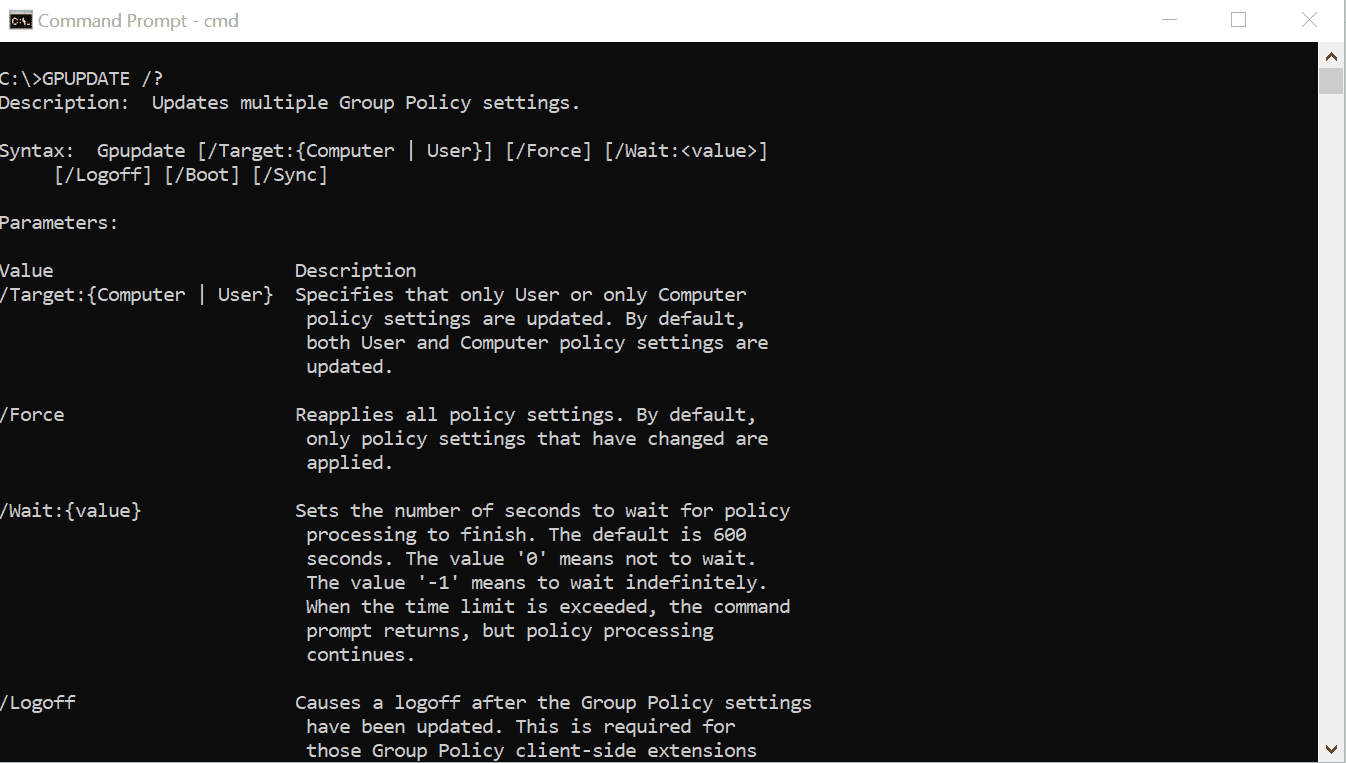Gpupdate Force
Gpupdate command is used to update Group policies in Windows operating system Domain. There are different options to use with the gpupdate but one of the most used option is /force which will reapply all policy settings. Even “gpupdate” command provides very basic features we may need to get some help about the options. Don’t use GPUpdate /force. Adding the /force switch causes the Group Policy service to reprocess all policies, not just the changes. This is more taxing to the domain controllers and the client computers, and is only required when you believe there’s a problem with Group Policy applying correctly. No problem = no /force. To Force Update Group Policy Settings in Windows 10 Manually. Open an elevated command prompt. To force apply only the changed policies, type or copy-paste the following command: gpupdate; To force update all policies, run the command: gpupdate /force; The commands above will update both User Group Policies and Computer Group Policies. I'm looking for the equivalent of gpupdate /force to force a refresh of group policy when on-prem, but for for MDATP. Update (sorry for not zeroing in on this): I'm thinking in terms of indicators - e.g. If I go into Settings, add a File indicator, and set it to Alert and Block. I would hope that this isn't driven solely by the logs on the back. How To GPUpdate on Remote Computers - Tips & Tricks. This might be an old trick but I just recently had a need doing it and thought it might be a good idea sharing.

When I first started learning about Active Directory, Group Policy always seemed very fickle. Sometimes I could run GPUpdate, other times I had to run /force.
As it turned out, Group Policy was always working – I just didn’t understand it. So what’s the difference between GPUpdate and GPUpdate /force? Well –
GPUpdate: Applies any policies that is new or modified
GPUpdate /force: Reapplies every policy, new and old.
So which one should I use? 99% of the time, you should only run gpupdate. If you just edited a GPO and want to see results immediately, running gpupdate will do the trick. In fact, running GPUPdate /force on a large number of computers can be damaging to your career. This is because these machines will hit a domain controller and reevaluate every GPO applicable to them.
Note: If you are looking for the remote version of GPUpdate in Active Directory Users and Computers, see this guide.
Anything else?
Since you asked, why yes there is! GPUpdate has a few other options for you to use.
/LogOff: Certain GPOS, such as Folder Redirection, can’t apply in the background. If a logoff is required, this switch will initiate it.
/Boot: If a policy, such as software installation, needs to be applied – the boot command will reboot the machine.
/Sync: Useful for changing the foreground (startup/logon) processing to synchronous.
…Enlightening…


Sarcasm aside, yes it is! You probably noticed a lack of remote support with GPUpdate. To address this, Microsoft introduced the Invoke-GPUpdate cmdlet. Here is an example:
Gpupdate Verbose
Invoke-GPUpdate -Computer COMPUTERNAME -Force
Gpupdate Force Cmd
or
$Computers = Get-AdComputer -SearchBase “OU=Brunswick, DC=Test,DC=local” -Filter *
Foreach ($Computer in $Computers) {invoke-gpupdate -Computer $Computers.Name}
Got an easier way to GPUpdate?
The example above might not be the most practical way of initiating a GPUpdate. Knowing this, Microsoft included the ability to start a GPUpdate remotely in the Server 2012/Windows 8 version of Group Policy Management Console.

As you can see in the picture above, right clicking on any OU will allow you to trigger a remote GPUpdate. Microsoft provided a little security with this tool by not allowing a GPUpdate at the domain level. However, this only works within Group Policy Management. Because a good bit of my work is done within Active Directory Users and Computer, I prefer this method of running a remote GPUpdate.
GPUpdate seemed like such a simple tool. As you now know, it is very powerful and completely customizable to your situation and environment. So the next time you see an administrator running an unwarranted gpupdate /force, explain the differences and let your domain controllers take a breather! And now that GPUpdate has been straightened out, have you been running GPResult remotely?
Gpupdate Force Failed
Finally, if you want to learn more about Group Policy and how it will make your life easier, then subscribe to DeployHappiness and get great weekly tips (plus your free guide to the Windows 8 Administrative Start Menu)!
